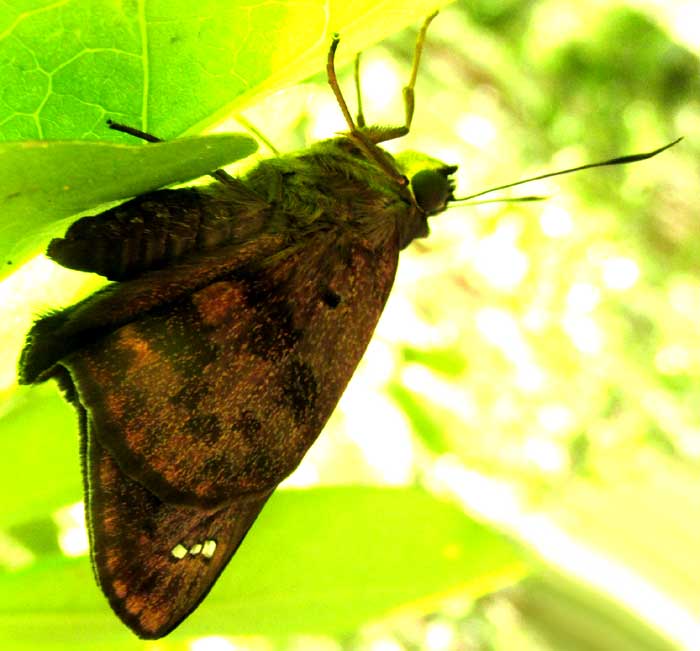Excerpts from Jim Conrad's
Naturalist Newsletter
from the August 2, 2018 Newsletter with notes from a July, 2018 camping trip to southeastern Campeche, MÉXICO
MANUEL'S SKIPPER AT DUSK
During my recent camping trip to southeastern Campeche state, on July 3rd as evening was coming on and a storm threatened rain, I was in my tent in the forest not far from Becán on the highway between Chetumal and Escárcega. From my vantage point looking up through the tent's see-through mosquito-net webbing, several dark, skipper-type butterflies could be seen on the undersurfaces of leaves all around me. One of those skippers is shown below -- the picture's background grossly overexposed so that patterns show in the heavy shade:

This skipper was first identified as a Spotted Polygon, Polygonus pardus. However, in 2024, when the image was uploaded to iNaturalist, user "aleturkmen" recognized the almost identical POLLYGONUS PARDUS, the Spotted Polygon.
By comparing pictures, I'm unable to distinguish the two species. I see very modest differences on the width of dark splotches and configuration of the three small, white quadrangles, but these vary from individual to individual. User "aleturkmen" appears to be a published expert in Mexican butterflies, so I'll go with his ID.
Polygonus pardus is distributed from southern Texas south to Panama.
On one leaf beside the tent something worth noting was observed. A skipper of the same species had positioned himself on a leaf's undersurface, near the leaf's drip-tip, and facing toward the leaf's stem or petiole, with its wings spread so that their tips extended on both sides of the leaf beyond the leaf's margins. In this position, the wings' translucent window spots were visible from above the leaf, on both sides of the leaf. With the leaf's drooping tip forming a V, and brightly translucent spots on both sides of the V, it almost looked like the face of an owl with bright eyes. Was this a behavioral adaptation for scaring away skipper-eating birds? It certainly was neatly done, the spots exactly where they should be and equidistant from the leaf's margins, just as in a face.
However, beneath other leaves the species could be seen aligning themselves randomly. Maybe someday a researcher will find that a certain percentage of individuals in any resting gathering of this species do align themselves as described above, just enough to keep skipper-eating birds in the area nervous.